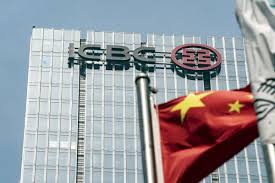
China's largest banks reported profit growth for the third quarter, although profitability was pressured by tighter margins and tepid loan demand as the economy's recovery continues to face headwinds. Agricultural Bank of China Ltd (AgBank) led with a 5.88% increase in net profit, while other major banks, including Industrial and Commercial Bank of China (ICBC) and China Construction Bank Corp (CCB), saw profits rise modestly.
ICBC, the world's largest commercial bank by assets, reported a 3.8% year-on-year profit increase, and the Bank of China (BoC) and Bank of Communications followed closely with profit rises of 4.38% and 1.2%, respectively. However, with loan demand still lukewarm and pressure on net interest margins (NIM) — a key profitability measure — Chinese banks are grappling with narrowing income from interest-earning assets.
BoC’s NIM slipped to 1.41% by the end of September, compared to 1.44% in June, and CCB’s margin fell to 1.52% from 1.54% over the same period. The decline in margins reflects challenges banks face in balancing profitability with supportive lending rates intended to stimulate economic growth. "We expect net interest margin pressure to persist in the fourth quarter," noted Vivian Xue, director at Fitch Ratings. “The measures announced by the Chinese authorities to support the economy will likely add to pressure on bank profitability.”
In response to these pressures, China’s major state-owned banks have reduced deposit rates for the second time this year, a move aligned with the government’s broader stimulus package to revitalize the economy. Additionally, authorities recently outlined plans to strengthen capital reserves for top lenders, aiming to help banks manage risks associated with asset quality and prevent systemic financial instability. This capital-raising trend is expected to persist, as noted by Xue, due to the ongoing demands of economic support and refinancing obligations.
Efforts to ease profitability constraints have included cuts to mortgage rates and the loan prime rate, which should help lower borrowing costs and boost credit demand. However, whether these adjustments will sufficiently revive lending remains uncertain. Xue added, "The effect of the mortgage rate cuts and loan prime rate cuts on NIM will be mitigated by reductions in reserve requirement ratios and deposit rates, but it is unclear whether they will be sufficient to revive credit demand."
While non-performing loan (NPL) ratios remained steady across most of the major lenders, BoC reported a slight uptick, with its NPL ratio edging up to 1.26% from 1.24% three months earlier. This slight increase hints at the challenges banks face in asset quality amidst a sluggish economic backdrop and a prolonged crisis in the property sector.
As the Chinese government continues to implement policies aimed at bolstering economic growth, the country’s banks are likely to encounter ongoing pressures on profitability. The balancing act of supporting the economy while safeguarding financial stability remains a primary focus, with state-owned banks positioned as key players in this delicate process.
(Source:www.reuters.com)
ICBC, the world's largest commercial bank by assets, reported a 3.8% year-on-year profit increase, and the Bank of China (BoC) and Bank of Communications followed closely with profit rises of 4.38% and 1.2%, respectively. However, with loan demand still lukewarm and pressure on net interest margins (NIM) — a key profitability measure — Chinese banks are grappling with narrowing income from interest-earning assets.
BoC’s NIM slipped to 1.41% by the end of September, compared to 1.44% in June, and CCB’s margin fell to 1.52% from 1.54% over the same period. The decline in margins reflects challenges banks face in balancing profitability with supportive lending rates intended to stimulate economic growth. "We expect net interest margin pressure to persist in the fourth quarter," noted Vivian Xue, director at Fitch Ratings. “The measures announced by the Chinese authorities to support the economy will likely add to pressure on bank profitability.”
In response to these pressures, China’s major state-owned banks have reduced deposit rates for the second time this year, a move aligned with the government’s broader stimulus package to revitalize the economy. Additionally, authorities recently outlined plans to strengthen capital reserves for top lenders, aiming to help banks manage risks associated with asset quality and prevent systemic financial instability. This capital-raising trend is expected to persist, as noted by Xue, due to the ongoing demands of economic support and refinancing obligations.
Efforts to ease profitability constraints have included cuts to mortgage rates and the loan prime rate, which should help lower borrowing costs and boost credit demand. However, whether these adjustments will sufficiently revive lending remains uncertain. Xue added, "The effect of the mortgage rate cuts and loan prime rate cuts on NIM will be mitigated by reductions in reserve requirement ratios and deposit rates, but it is unclear whether they will be sufficient to revive credit demand."
While non-performing loan (NPL) ratios remained steady across most of the major lenders, BoC reported a slight uptick, with its NPL ratio edging up to 1.26% from 1.24% three months earlier. This slight increase hints at the challenges banks face in asset quality amidst a sluggish economic backdrop and a prolonged crisis in the property sector.
As the Chinese government continues to implement policies aimed at bolstering economic growth, the country’s banks are likely to encounter ongoing pressures on profitability. The balancing act of supporting the economy while safeguarding financial stability remains a primary focus, with state-owned banks positioned as key players in this delicate process.
(Source:www.reuters.com)














